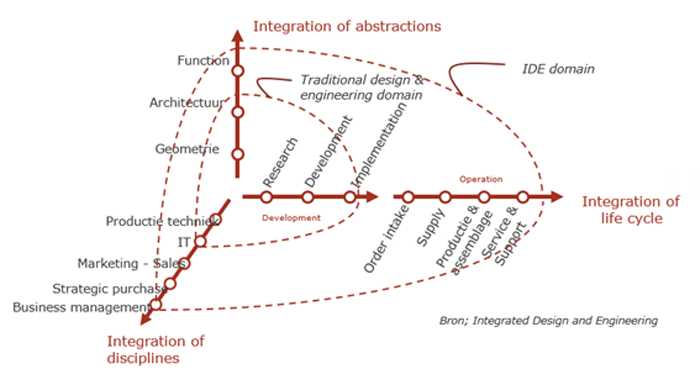
The innovation roadmap can be divided into three stages, including the development stage. This stage includes all development activities that need to be taken for developing smart and flexible product platforms. This includes specification, designing, prototyping and testing of the innovation.
We always design and develop from an integral approach, using a modern toolbox to get the best result. In this article, I will explain the integral model and describe why development from an integral way of thinking and approach becomes increasingly important.
To be able to make the right considerations within engineering, an integral approach is necessary. With ‘integral’ we mean ‘assessed across the entire chain’. We have grasped the integral approach in a three axes model.
The integral approach in system development is important because a design can only be successful when it meets all the desired specifications of the stakeholders. Across the entire chain, stakeholders and users can be indicated, each with their own voice and interests. Because of these diverging interests (and desired specifications) different perceptions of value will arise. To come to good development choices, despite the various value perceptions, it is of great importance that there is always a careful integral consideration.
The life cycle and discipline axis together contain all possible wishes and demands of the stakeholders and the users. But per axis there is a difference with regard to types of interests. Below, the three axes are explained:
- Integration of life cycle:
Refers to: development & operation
The life cycle axis takes into account the specifications of the stakeholders/users, such as design, production, assembly, use, but also, for example, depreciation.
- Integration of disciplines:
Refers to: production technique, IT, Marketing/Sales, procurement and business management
The discipline axis is about the disciplines coming from the client. Or, the design should fit into the way they want to put products on the market and sell them. And it should correspond with the way in which they would like to manage the design and direct the chain.
- Integration of abstractions:
Refers to: geometry, architecture and function
The vertical axis, the integration of abstractions, is realised by ‘peeling off’ all specifications in the other two axes. So in fact, we first look at the issue and the design in an abstract manner on the basis of all specifications. The result: an abstract image of functions, modules and components.
The result of these three axes together, constitutes a design philosophy with which we can approach designing and development in an integral manner.
Growing importance of integral thinking in System Development
The integral approach is increasingly important in a market with more and more competition. The great advantage of integral thinking is the fact that you will get more information and data at an earlier stage.
Where engineers previously only had an idea of the technical challenges and had to solve any technical issues, they have now insight into the influence of certain choices on, for example, cost price and assembly time. He/she can therefore already take into account such integral aspects during the design stage. This leads to, for example, a lower cost price, shorter lead time and less costs of failure.






